Xiaofeng Mou
Aggregation of Reasoning: A Hierarchical Framework for Enhancing Answer Selection in Large Language Models
May 21, 2024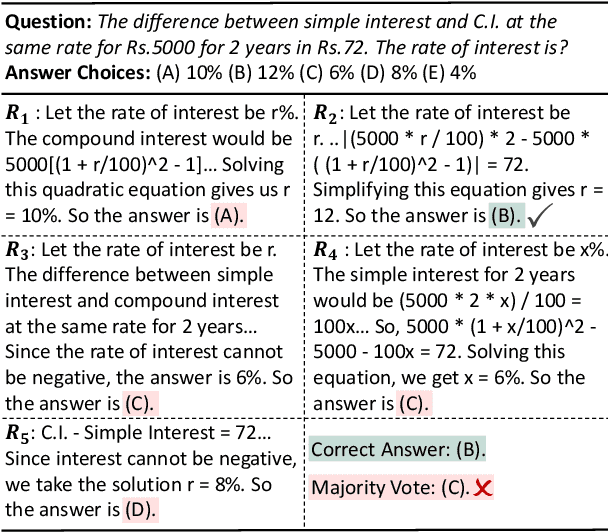


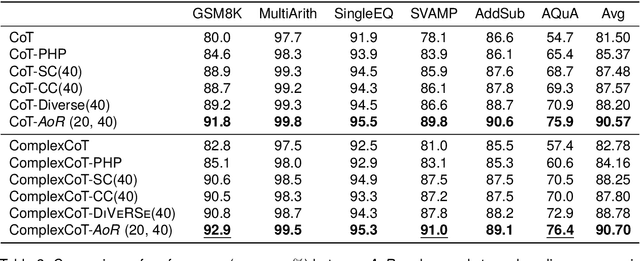
Abstract:Recent advancements in Chain-of-Thought prompting have facilitated significant breakthroughs for Large Language Models (LLMs) in complex reasoning tasks. Current research enhances the reasoning performance of LLMs by sampling multiple reasoning chains and ensembling based on the answer frequency. However, this approach fails in scenarios where the correct answers are in the minority. We identify this as a primary factor constraining the reasoning capabilities of LLMs, a limitation that cannot be resolved solely based on the predicted answers. To address this shortcoming, we introduce a hierarchical reasoning aggregation framework AoR (Aggregation of Reasoning), which selects answers based on the evaluation of reasoning chains. Additionally, AoR incorporates dynamic sampling, adjusting the number of reasoning chains in accordance with the complexity of the task. Experimental results on a series of complex reasoning tasks show that AoR outperforms prominent ensemble methods. Further analysis reveals that AoR not only adapts various LLMs but also achieves a superior performance ceiling when compared to current methods.
Retrieval-Augmented Embodied Agents
Apr 17, 2024



Abstract:Embodied agents operating in complex and uncertain environments face considerable challenges. While some advanced agents handle complex manipulation tasks with proficiency, their success often hinges on extensive training data to develop their capabilities. In contrast, humans typically rely on recalling past experiences and analogous situations to solve new problems. Aiming to emulate this human approach in robotics, we introduce the Retrieval-Augmented Embodied Agent (RAEA). This innovative system equips robots with a form of shared memory, significantly enhancing their performance. Our approach integrates a policy retriever, allowing robots to access relevant strategies from an external policy memory bank based on multi-modal inputs. Additionally, a policy generator is employed to assimilate these strategies into the learning process, enabling robots to formulate effective responses to tasks. Extensive testing of RAEA in both simulated and real-world scenarios demonstrates its superior performance over traditional methods, representing a major leap forward in robotic technology.
2023 Low-Power Computer Vision Challenge (LPCVC) Summary
Mar 11, 2024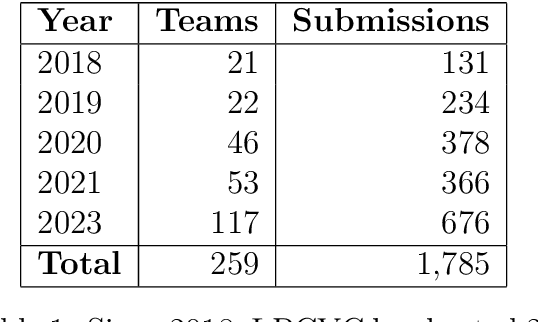
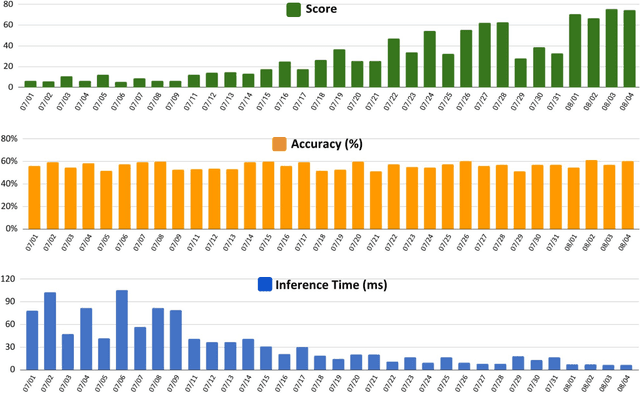

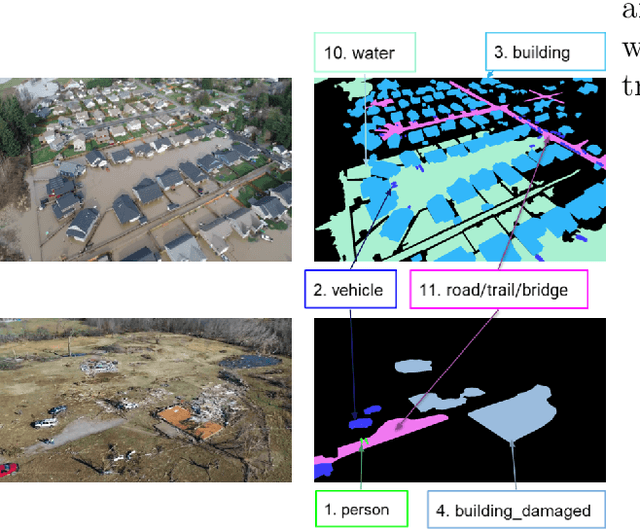
Abstract:This article describes the 2023 IEEE Low-Power Computer Vision Challenge (LPCVC). Since 2015, LPCVC has been an international competition devoted to tackling the challenge of computer vision (CV) on edge devices. Most CV researchers focus on improving accuracy, at the expense of ever-growing sizes of machine models. LPCVC balances accuracy with resource requirements. Winners must achieve high accuracy with short execution time when their CV solutions run on an embedded device, such as Raspberry PI or Nvidia Jetson Nano. The vision problem for 2023 LPCVC is segmentation of images acquired by Unmanned Aerial Vehicles (UAVs, also called drones) after disasters. The 2023 LPCVC attracted 60 international teams that submitted 676 solutions during the submission window of one month. This article explains the setup of the competition and highlights the winners' methods that improve accuracy and shorten execution time.
EPSD: Early Pruning with Self-Distillation for Efficient Model Compression
Jan 31, 2024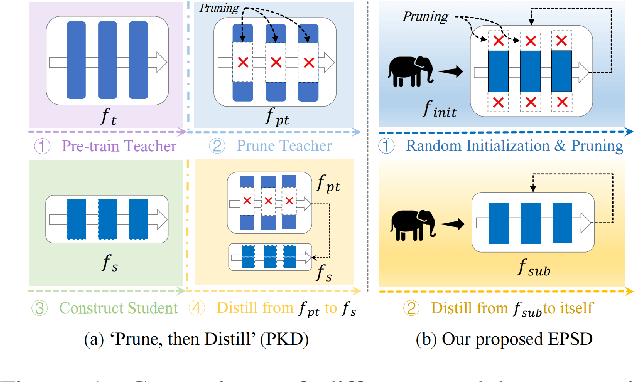
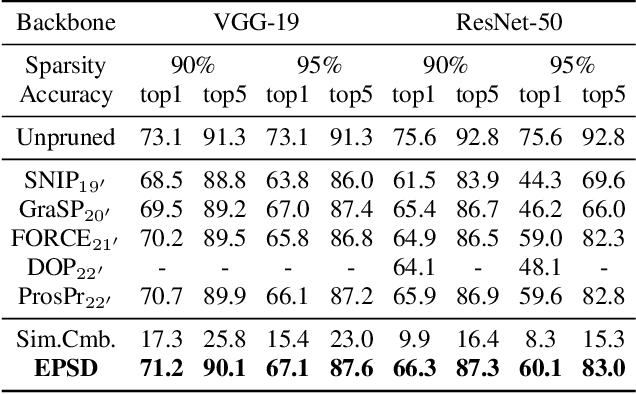

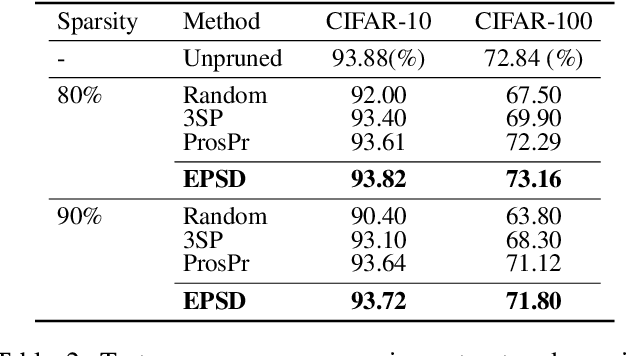
Abstract:Neural network compression techniques, such as knowledge distillation (KD) and network pruning, have received increasing attention. Recent work `Prune, then Distill' reveals that a pruned student-friendly teacher network can benefit the performance of KD. However, the conventional teacher-student pipeline, which entails cumbersome pre-training of the teacher and complicated compression steps, makes pruning with KD less efficient. In addition to compressing models, recent compression techniques also emphasize the aspect of efficiency. Early pruning demands significantly less computational cost in comparison to the conventional pruning methods as it does not require a large pre-trained model. Likewise, a special case of KD, known as self-distillation (SD), is more efficient since it requires no pre-training or student-teacher pair selection. This inspires us to collaborate early pruning with SD for efficient model compression. In this work, we propose the framework named Early Pruning with Self-Distillation (EPSD), which identifies and preserves distillable weights in early pruning for a given SD task. EPSD efficiently combines early pruning and self-distillation in a two-step process, maintaining the pruned network's trainability for compression. Instead of a simple combination of pruning and SD, EPSD enables the pruned network to favor SD by keeping more distillable weights before training to ensure better distillation of the pruned network. We demonstrated that EPSD improves the training of pruned networks, supported by visual and quantitative analyses. Our evaluation covered diverse benchmarks (CIFAR-10/100, Tiny-ImageNet, full ImageNet, CUB-200-2011, and Pascal VOC), with EPSD outperforming advanced pruning and SD techniques.
LLaVA-Phi: Efficient Multi-Modal Assistant with Small Language Model
Jan 15, 2024Abstract:In this paper, we introduce LLaVA-$\phi$ (LLaVA-Phi), an efficient multi-modal assistant that harnesses the power of the recently advanced small language model, Phi-2, to facilitate multi-modal dialogues. LLaVA-Phi marks a notable advancement in the realm of compact multi-modal models. It demonstrates that even smaller language models, with as few as 2.7B parameters, can effectively engage in intricate dialogues that integrate both textual and visual elements, provided they are trained with high-quality corpora. Our model delivers commendable performance on publicly available benchmarks that encompass visual comprehension, reasoning, and knowledge-based perception. Beyond its remarkable performance in multi-modal dialogue tasks, our model opens new avenues for applications in time-sensitive environments and systems that require real-time interaction, such as embodied agents. It highlights the potential of smaller language models to achieve sophisticated levels of understanding and interaction, while maintaining greater resource efficiency.The project is available at {https://github.com/zhuyiche/llava-phi}.
Is MultiWOZ a Solved Task? An Interactive TOD Evaluation Framework with User Simulator
Oct 26, 2022Abstract:Task-Oriented Dialogue (TOD) systems are drawing more and more attention in recent studies. Current methods focus on constructing pre-trained models or fine-tuning strategies while the evaluation of TOD is limited by a policy mismatch problem. That is, during evaluation, the user utterances are from the annotated dataset while these utterances should interact with previous responses which can have many alternatives besides annotated texts. Therefore, in this work, we propose an interactive evaluation framework for TOD. We first build a goal-oriented user simulator based on pre-trained models and then use the user simulator to interact with the dialogue system to generate dialogues. Besides, we introduce a sentence-level and a session-level score to measure the sentence fluency and session coherence in the interactive evaluation. Experimental results show that RL-based TOD systems trained by our proposed user simulator can achieve nearly 98% inform and success rates in the interactive evaluation of MultiWOZ dataset and the proposed scores measure the response quality besides the inform and success rates. We are hoping that our work will encourage simulator-based interactive evaluations in the TOD task.
Few Clean Instances Help Denoising Distant Supervision
Sep 14, 2022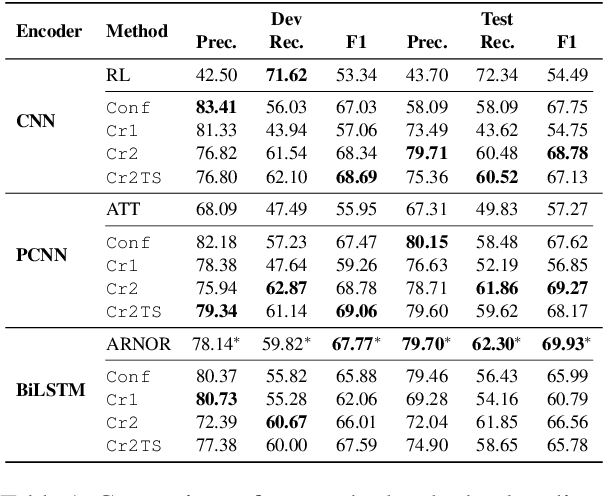
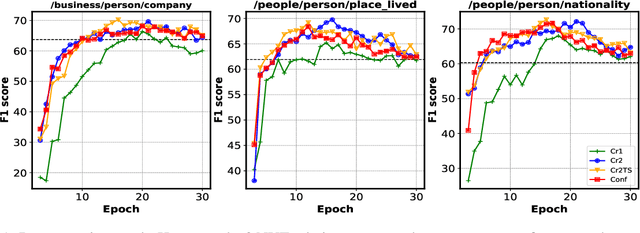
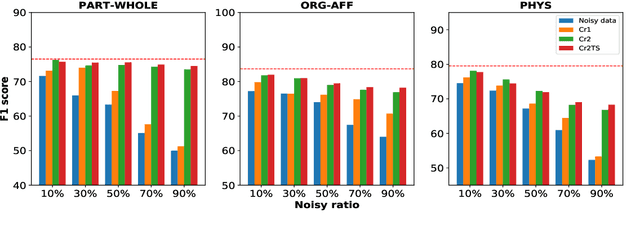
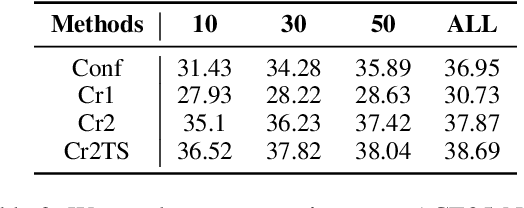
Abstract:Existing distantly supervised relation extractors usually rely on noisy data for both model training and evaluation, which may lead to garbage-in-garbage-out systems. To alleviate the problem, we study whether a small clean dataset could help improve the quality of distantly supervised models. We show that besides getting a more convincing evaluation of models, a small clean dataset also helps us to build more robust denoising models. Specifically, we propose a new criterion for clean instance selection based on influence functions. It collects sample-level evidence for recognizing good instances (which is more informative than loss-level evidence). We also propose a teacher-student mechanism for controlling purity of intermediate results when bootstrapping the clean set. The whole approach is model-agnostic and demonstrates strong performances on both denoising real (NYT) and synthetic noisy datasets.
 Add to Chrome
Add to Chrome Add to Firefox
Add to Firefox Add to Edge
Add to Edge